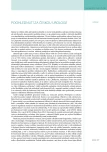Contribution of laparoscopy in diagnostics and treatment of non-palpable testes
Authors:
David Míka; Ondřej Havránek; David Němec; Jan Krhut
Authors‘ workplace:
Ostrava
; Urologické oddělení Fakultní nemocnice
Published in:
Ces Urol 2011; 15(3): 167-171
Category:
Original article
Overview
Aim:
The aim of the study is to confirm laparoscopy as the first choice method, used for diagnostics and for treatment of non-palpable testes.
Material and methods:
Retrospectively we evaluated a set of 14 children with non–palpable testes, that were treated in our department from 2005 to 2010 in which we carried out laparoscopy. The average age was 31 months (7–96 months). Insufflation of capnoperitoneum was carried out from infraumbilical incision up to pressure 10–12 torr. Capnoperitoneum was established with Veress needle in 10 cases, preparation technique was used in 4 cases. Two 5mm ports were inserted into the abdominal cavity for preparation on both sides in lower quadrants.
Results:
In 7 cases (50%) we found testicle near the deep ring in abdominal cavity, 3× (22%) in inguinal chanel, in 2 cases (14%) we found blindly ending vessels and ductus deferens, 1× (7%) atrophic testicle located in the top of the scrotum and 1× (7%) ectopic testicle in femoral chanel. In 9 cases (64%) we carried out one-stage orchidopexy, from that in one case we dissected internal spermatic vessels according to Fowler-Stephens. In two cases (14%) we carried out two-stage orchidopexy. In one case (7%) orchiectomy was made and in two cases (14%) anorchia was diagnosed. In one case an absces in the wound developed and was treated with drainage and antibiotics. The rest of operations were not complicated.
Conclusion:
The use of laparoscopy carried out in case of non-palpable testes is currently safe and effective method. Its contribution can be very helpful in case of high retention and the anorchia. Whereas it doesn’t exist another alternative used in diagnostics and treatment of non-palpable testis, we consider it as a method of the first choice.
Key words:
cryptorchidism, laparoscopy, non-palpable testes, orchiopexy.
Sources
1. Berkowitz GS, Lapinski RH, Dolgin SE, et al. Prevalence and natural history of cryptorchidism. Pediatrics 1993; 92: 44 –49.
2. John Radcliffe Hospital Cryptorchidism Study Group. Cryptorchidism: a prospective study of 7500 consecutive male births, 1984–1988. Arch Dis Child 1992; 67: 892–899.
3. Scorer C. The descent of the testis. Arch Dis Child 1964; 39: 605–609.
4. Thonneau PF, Gandia P, Mieusset R. Cryptorchidism: incidence, risk factors, and potential role of environment; anupdate. J Androl 2003; 24: 155–162.
5. Tasian GE, Copp HL. Diagnostic performance of ultrasound in nonpalpable cryptorchidism: a systematic review and meta-analysis. Pediatrics 2011; 127(1): 119–128.
6. Yeung CK, Tam YH, Chan YL, et al. A new management algorithm for impalpable undescended testis with gadolinium enhanced magnetic resonance angiography. J Urol 1999; 162(3 Pt 2): 998–1002.
7. Kanemoto K, Hayashi Y, Kojima Y, et al. Accuracy of ultrasonography and magnetic resonance imaging in the diagnosis of non-palpable testis. Int J Urol 2005; 12(7): 668–672.
8. Meyer T, Höcht B. Long term results of orchidopexy: transscrotal fixation versus Dartospouch. Zentralbl Chir 2004; 129(6): 476–479.
9. Lindgren BW, Franco I, Blick S, et al. Laparoscopic Fowler-Stephens orchiopexy for the high abdominal testis. J Urol 1999; 162(3 Pt 2): 990–993.
10. Huff DS, Hadziselimovic F, Snyder HM 3rd, et al. Histologic maldevelopment of unilaterally cryptorchid testes and their descended partners. Eur J Pediatr 1993; 152(Suppl 2): S11–S14.
11. Kočvara R. Kryptorchizmus: kdy načasovat a jakou léčbu provést? Urologické listy 2007; 5(1): 30–33.
12. Kočvara R. Kryptorchizmus. In: Urologie, 1. vyd. Praha: ISV nakladatelství 1994; 1296–1280.
13. Drlík M, Kočvara R, Sedláček J, Dítě Z. Přínos laparoskopie v léčbě nehmatného varlete. Čes Urol 2011; 15(1): 52.
14. Radmayr C, Oswald J, Schwentner C, et al. Long-term outcome of laparoscopically managed nonpalpable testes. J Urol 2003; 170(6 Pt 1): 2409–2411.
15. Wacksman J, Billmire DA, Lewis AG, et al. Laparoscopically assisted testicular autotransplantation for management of the intraabdominal undescended testis. J Urol 1996; 156(2 Pt 2): 772–774.
16. Rajfer J, Handelsman DJ, Swerdloff RS, et al. Hormonal therapy of cryptorchidism. A randomized, double-blind study comparing human chorionic gonadotropin and gonadotropin-releasing hormone. N Engl J Med 1986; 314(8): 466–470.
17. Pyörälä S, Huttunen NP, Uhari M. A review and meta-analysis of hormonal treatment of cryptorchidism. J Clin Endocrinol Metab 1995; 80(9): 2795–2799.
18. Husmann DA. Cryptorchidism. In: Belman K, et al. (eds.) Clinical Pediatric Urology. 4 vyd. London: Martin Dunith Ltd 2002; 1125–1154.
19. Šmakal O. Zapletalová J. Polohové anomálie varlat – diagnostika a léčba. Urologie pro praxi 2002; 2: 49–51.
20. Lisá L. Nesestouplá varlata. Čs Pediat 1996; 51: 235–237.
21. Svitač J, Kliment J. Nehmatné testis – diagnostika a liečba. Rozhl Chir 1992; 71: 688–692.
22. Petřivalský J. Retentio testis inguinalis. Čas Lék čes 1931; 70: 629.
Labels
Paediatric urologist Nephrology UrologyArticle was published in
Czech Urology

2011 Issue 3
Most read in this issue
- EARLY SURGICAL MANAGEMENT OF URETERAL TRAUMA
- Contribution of laparoscopy in diagnostics and treatment of non-palpable testes
- Late secondary bleeding after percutaneus nephrolithotomy
- Prevalence of the overactive bladder symptoms among patients of urological outpatient clinics
